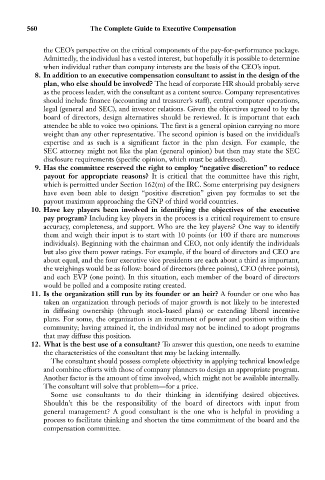Page 574 - Bruce Ellig - The Complete Guide to Executive Compensation (2007)
P. 574
560 The Complete Guide to Executive Compensation
the CEO’s perspective on the critical components of the pay-for-performance package.
Admittedly, the individual has a vested interest, but hopefully it is possible to determine
when individual rather than company interests are the basis of the CEO’s input.
8. In addition to an executive compensation consultant to assist in the design of the
plan, who else should be involved? The head of corporate HR should probably serve
as the process leader, with the consultant as a content source. Company representatives
should include finance (accounting and treasurer’s staff), central computer operations,
legal (general and SEC), and investor relations. Given the objectives agreed to by the
board of directors, design alternatives should be reviewed. It is important that each
attendee be able to voice two opinions. The first is a general opinion carrying no more
weight than any other representative. The second opinion is based on the invididual’s
expertise and as such is a significant factor in the plan design. For example, the
SEC attorney might not like the plan (general opinion) but then may state the SEC
disclosure requirements (specific opinion, which must be addressed).
9. Has the committee reserved the right to employ “negative discretion” to reduce
payout for appropriate reasons? It is critical that the committee have this right,
which is permitted under Section 162(m) of the IRC. Some enterprising pay designers
have even been able to design “positive discretion” given pay formulas to set the
payout maximum approaching the GNP of third world countries.
10. Have key players been involved in identifying the objectives of the executive
pay program? Including key players in the process is a critical requirement to ensure
accuracy, completeness, and support. Who are the key players? One way to identify
them and weigh their input is to start with 10 points (or 100 if there are numerous
individuals). Beginning with the chairman and CEO, not only identify the individuals
but also give them power ratings. For example, if the board of directors and CEO are
about equal, and the four executive vice presidents are each about a third as important,
the weighings would be as follow: board of directors (three points), CEO (three points),
and each EVP (one point). In this situation, each member of the board of directors
would be polled and a composite rating created.
11. Is the organization still run by its founder or an heir? A founder or one who has
taken an organization through periods of major growth is not likely to be interested
in diffusing ownership (through stock-based plans) or extending liberal incentive
plans. For some, the organization is an instrument of power and position within the
community; having attained it, the individual may not be inclined to adopt programs
that may diffuse this position.
12. What is the best use of a consultant? To answer this question, one needs to examine
the characteristics of the consultant that may be lacking internally.
The consultant should possess complete objectivity in applying technical knowledge
and combine efforts with those of company planners to design an appropriate program.
Another factor is the amount of time involved, which might not be available internally.
The consultant will solve that problem—for a price.
Some use consultants to do their thinking in identifying desired objectives.
Shouldn’t this be the responsibility of the board of directors with input from
general management? A good consultant is the one who is helpful in providing a
process to facilitate thinking and shorten the time commitment of the board and the
compensation committee.

